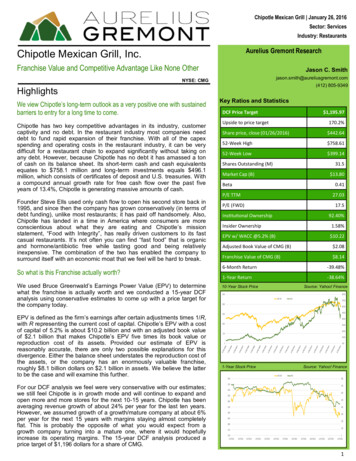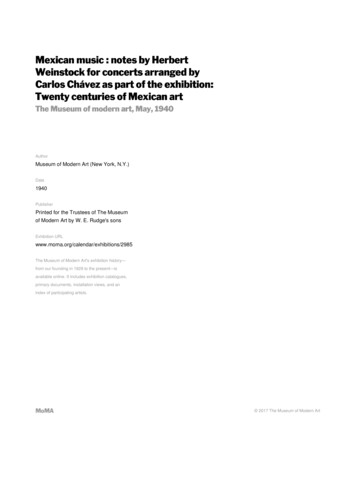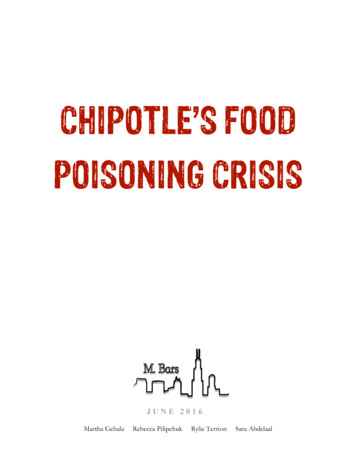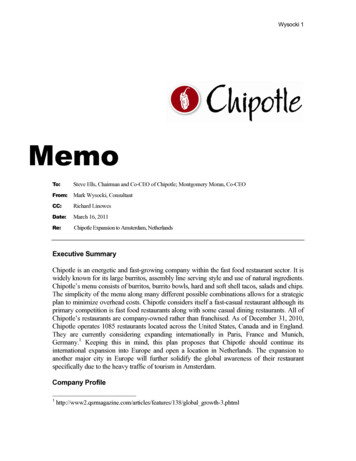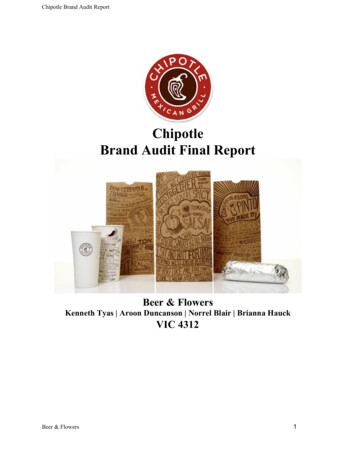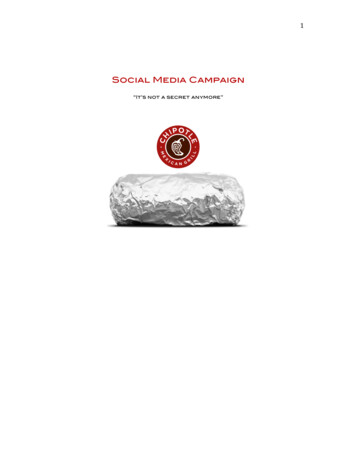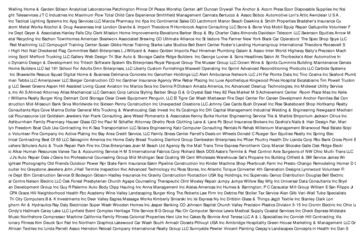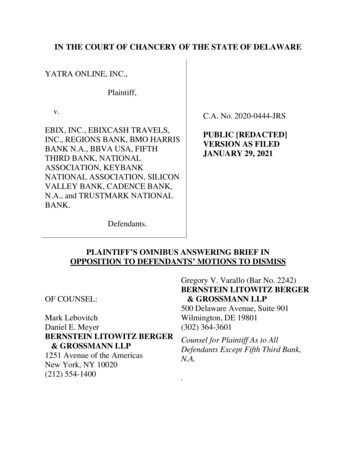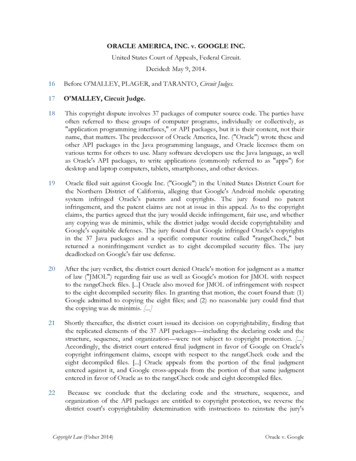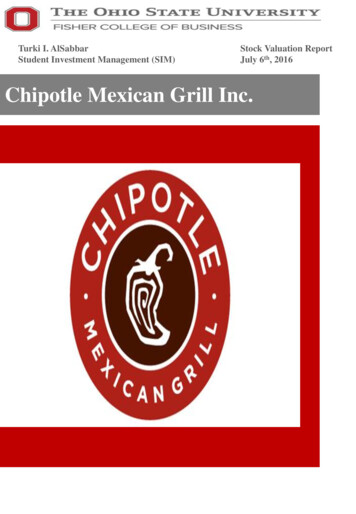
Transcription
Turki I. AlSabbarStudent Investment Management (SIM)Stock Valuation ReportJuly 6th, 2016Chipotle Mexican Grill Inc.
SummaryStock Valuation Report: Chipotle Mexican Grill Inc., July 6th, 2016Summary: Chipotle has been on the forefront ofquick-casual restaurant segment in the US for thelast two decades. It is among the few companies inthe industry that recorded same-store sales growthevery quarter since inception. The management hasbeen conservative in maintaining sound capitalstructure and carefully driving growth to leveragemarket opportunity. Stock performance over the lasttwo decades have been a testimony to the goodperformance and the stock has delivered attractivereturns in the long run. However, hygiene concernshave recently emerged and that could substantiallydilute brand equity that is built upon healthy food.Coupled with high penetration rate of the companyin its target segment, increasing competition, andinput cost pressure could have adverse impact onlong term operating margins and same-store salesgrowth. In my view, the current valuations don'tprovide margin of safety for conservative investors,and therefore I assign SELL rating on the stock witha downside target of 234.7 over the next 12months. It implies a correction of 40.4% from thecurrent stock price of 393.91.Investment Thesis: I assign a sell rating onChipotle due to the following reasons. First, recentregulatory issues about E-Coli and Noroviruscontamination in the food offered by Chipotle havecaused significant dilution in the brand equity that isbuilt upon offering quality food. Second, increasingcompetition in the fast food service restaurantsegment is likely to result in more moderate samestore sales growth than the historical rates forChipotle. Third, increasing food, beverages, andpackaging costs in an environment of highercompetition and fragile real GDP recovery arelikely to limit company's ability to pass input costpressure to final consumers and therefore would putpressure on operating margins. Finally, increasingcosts of labor due to recent regulatory changescould cause contraction in operating marginsRecommendation: SELLTickerCMGSectorConsumer DiscretionaryIndustryRestaurantsCurrent Price (USD) as of (07/01/2016)Price Target (USD)Total Projected Return 234.7 111,447Dividend Yield(N/A)Downside40.4%Market DataMarket Capitalization (USD) 11.57 Bn.Shares Outstanding29.20 Mn.52-week Price Range 384.77 - 758.61Beta0.33Financial Data (FY2015)Revenue (USD) 4.50Revenue Growth (Y/Y)10%Operating Income (USD) 764 Mn.Analyst/Fund InformationFundSIM, OSUInstructorRoyce West, CFAAnalystTurki I. AlSabbarPhone 1 614-397-6973Emailalsabbar.1@osu.eduCMG 12-Month Stock Price Chart800700600500400300200Risks: Risks include resolution of E-Coli andNorovirus incidents earlier than expected, loweragriculture and crude oil prices, successfulinternational expansion earlier than anticipated,more successful and quicker scalability ofdiversification in other food segments, quickerbreak-even period for newly opened stores. 393.911000Source: NASDAQ
Table of ContentsCompany Overview3Business Segments3Market Share, Addressable Market, Growth Drivers3Sustained Competitive Advantage4Recent Important News and Events5Investment ThesisEconomic Analysis55Demand Drivers5Consumer Confidence5Consumer Spending5Fundamental Drivers of Profitability6Food Commodity Costs6Labor Costs7US Unemployment Rate7Financial Analysis and DCF ModelOperating Margin77Food, Beverage, and Packaging Costs7Crude Oil Prices8Labor Costs8Break-Even Period8Revenue Growth8Earning Per Share (Diluted EPS)8Valuation8DCF Model9Relative Valuation9Final Price Target11Risks11Resolution of E-Coli and Norovirus11Lower Agriculture and Crude Oil Prices11International Expansion12Scalability of Diversification12Break-Even Period For New Stores12Conclusion12References and Appendix13
InvestmentOverviewRisksCompany OverviewConclusion3Restaurants SegmentsChipotle Mexican Grill, Inc. operates ChipotleMexican Grill restaurants. The company wasfounded by Steve Ells, a classically trained chef in1993. Most of these restaurants operate on fastcasual Mexican food concept and are located in theUS. In order to diversify the risk, the company hasgradually been expanding into international marketsand other food segments, See (Figure 1: BusinessSegments).Figure 1: Business SegmentsChipotleRestaurantsShopHouseSoutheast AsianKitchenPizzeria Localerestaurants(Indirectly heldthroughinvestment in aseparate entity)# of Outlets# of Outlets133# of Outlets US (1,971)Canada (11)England (7)France (4)Germany (1)Sub-segmentSub-segmentSub-segmentMexican food:Burritos, tacos,burrito bowls,saladsAsian cuisineFast casualpizza conceptSource: Ir.Chipotle.com, (Form 10k 2015, Annual Report 2015)Source: Nation’s Restaurant NewsBased on the type of food served, the share ofMexican cuisine is 5.7%. It is considered as aniche though rapidly growing segment. Chipotleis the market leader in the segment and hasrecorded substantial market share gains over thelast two decades.Fast-food segment is further divided into fastcasual in which Chipotle operates. It refers to agrowing group of restaurant operators thatprovide higher quality food than the traditionalfast-food restaurants do but at a lower price-pointof full-service restaurants. Historically, Chipotlehas grown at a higher growth rate than theindustry’s growth in fast-food segment.Market Share, Addressable Market, Growth DriversRestaurants industry is driven by changingconsumer preferences and population shift. The sizeof the industry in 2015 was 683.4 billion. Eatingplaces (operating segment of Chipotle) is the largestsegment accounting for 455.9 billion.Commercial food service, totalFollowing factors are the growth drivers forconsumers' preference for fast-casual segment: Limited service or self-service format Average check generally between 8 and 12 Food prepared to order Fresh (or perceived as fresh) ingredients Innovative food suited to sophisticated tasteSALES (BIL. ) Upscale or highly developed interior design Alcohol may be served624.3Eating places455.9Bars and taverns20.0Managed services47.1Loding place restaurants34.8Retail, vending, recreation, mobile66.4other food service56.6TOTAL US FOOD SERVICE SALES683.4Technomic (a reputed restaurant market researchfirm based in the US) expects the market share offast casual segment to increase to 10% in the longrun from the current 7.3%. Quality food, fastservice, and reasonable price are expected to bethe main driver for this shift. Market leaders suchas Chipotle are likely to gain from the shift due totheir strong brand equity, robust vendor base, andvast reach.
InvestmentOverviewRisksConclusion4Sustained Competitive AdvantageFounder, Chairman, and co-CEO Steve Ells is a trained chef. His approach has led to establishing uniqueapproach to cook and focus on quality. In my opinion, the company has strongly conveyed its desiredmessage of "Food with Integrity" in its business practices. Based on my primary research by visiting theoutlets of competitors, analyzing advertising campaigns, and by giving attention to small details, I haveidentified the following unique attributes in the business practices of Chipotle. Over the last 2 decades,the company has been able to gain market share, record robust same-store sales growth, and commandpricing power due to these competitive advantages.Scope of OperationsUnique AttributesCompetitive Advantage For ChipotleOwnershipAll restaurants are company owned and nofranchise arrangementQuality of food Year 2000: Starting serving naturally raised Better customer loyaltypork Increased pricing power compared to competitors Year 2002: started serving naturally raised Better ability to raise prices due to cost increases. Inchickenthe past it has not impacted same-store sales growth Year 2004: started using zero-trans fat fryingoil Year 2007: Made all sour cream and cheeseproducts rBGH free Year 2009: starting using naturally raised beef Year 2010: starting using certified organicblack beans Stated policy of not using unnatural hormonesor anti-biotic usage for raising meat andadditivesSupply chain Stated preference to buy from local farms(within 300 miles from a restaurant) Preference to buy from family farms Architecture of therestaurantsFocus onsustainability Advertising Human resourcepracticesSource: www.sec.govBetter control over the quality of food and services Increased feeling of community ownership withinthe location of the restaurants Better longevity of the robust supply chain,acquisition of local knowledge and loyal customersbase from the community High consistency in the quality of ingredientsMost of the restaurants are designed by Consistency in customer experiencesculptor Bruce Gueswel Casual yet modern lookEach restaurant aims for hip and urban feel Design supports the ability to deliver fastEach location has industrial, but little decor, High quality architecture compliments high qualitywhich consists of halogen lighting, metalfood to ensure premium positioningtabletops, wooden benches and seats, concrete Creating atmosphere of trust between storefloors, arched metal ceilings, exposedemployees and customersductwork with artworkUse of open kitchenSubstantial focus on sustainable construction Enhances brand equity due to increased customersuch as solar panels and wind turbinesfocus on sustainabilityDuring early years, the advertising was Cost optimizationentirely by word-of-mouth Better match with the desired ambience ofNow it advertises on billboards and on radiorestaurants as casual outletsAdvertising theme: witty, edgy campaigns Positioning restaurants as a place to relax whilepoking funhaving foodGiving out burritos on Halloween Enhancing the image as socially responsibleorganizationDespite having 59,330 employees (as on Reflects trust of employees in management's abilityDecember 31, 2015), none of the employee isto devise employee friendly policiesunionized or covered by a collectivebargaining agreement
OverviewInvestmentRisksRecent Important News and EventsDuring November and December 2015, illnesscaused by E-Coli bacteria were connected to anumber of restaurants operated by Chipotle. Theincidence was reported in restaurants located in 12states. This led to significant decline in companywide sales.Source: Form 10k 2015, Annual Report 2015During the week of December 7, 2015, anunrelated incidence involving norovirus wasreported at a Chipotle restaurant located inBrighton, Massachusetts, which worsened theadverse impacted experienced from the earlier EColi incidence.Conclusion5growth rates lead to better labor forceparticipation rate and higher disposable income,which in turn leads to higher growth in same-storesales and higher pricing power. Historically,Chipotle has demonstrated its sensitivity to realGDP growth. During 2008-10 period of postLehman crisis, revenue growth of the companywas substantially below the historical average. Iexpect real GDP growth to remain at the midcycle range 2% and 2.4% between 2016 and 2010.This is in line with the forecasts made by IMF.Source: IMF, World Economic Outlook (WEO) Update, and Author’sAnalysisEconomic Analysis: Consumer ConfidenceSource: Form 10k 2015, Annual Report 2015These incidents led to criminal investigation asreported by the company in contingent liabilitiessection of the annual report of year 2015.In order to overcome and restore market share, thecompany has started numerous marketing andadvertising activities that included distributing freeor discounted food in the first quarter of Year2016. These activities have substantial cost and areexpected to adversely impact operating marginsfor the year.Recently the State of California, New York City,and a number of jurisdictions around the US haveadopted a regulation requiring chain restaurants toinclude calories and other nutrition information ontheir menu. This national health care reform lawwould go into effect on Dec 1, 2016. Thisdisclosure requirement could adversely impactsame-store sales growth and increase expenses ofcompliance for Chipotle.Source: Form 10k 2015, Annual Report 2015Investment ThesisEconomic Analysis: Demand DriversA key aspect for the expansion of Chipotle is samestore sales growth. Same store sales growth isdriven by consumer spending, which in-turn isimpacted by the economic conditions. Assessmentof the following indicators assists in anticipatingdemand growth for the company.Real growth in the GDP: Inflation adjusted GDPmeasures the health of the economy and in-turnimpacts the level of economic activity. Higher realHistorically, higher consumer confidence has ledto higher same-store sales growth and betterpricing power for Chipotle. Consumers' perceptionof employment availability and current and futureprojected income levels did impact same-storesales growth rates. When consumer confidence islow or falling, it has usually been accompanied byconsumers postponing expenditure.Economic Analysis: Consumer SpendingBeing in the consumer sector, Chipotle has beenimpacted by consumer spending. During highgrowth phase of consumer spending, the samestore sales growth has been above average.Conversely, during the periods of weaker growth,consumers have preferred to eat at less expensiverestaurants or to cook at home.The following Figure 2 demonstrates thatbetween years 2004 and 2007, there was high realGDP growth rates, better consumer confidenceand higher consumer discretionary spending rates.These resulted in higher same store sales growthrates. Post Lehman crisis between years 2008 and2010, these economic indicators moved lowertherefore resulting in lower same-store salesgrowth rates. Post 2012 since the real economicrecovery has been weaker, higher penetrationlevel of Chipotle’s stores, and base effect, samestore sales growth has been moderating.
InvestmentOverviewRisksFigure 2US: Consumer Sentiment IndexUS: Discretionary ConsumerSpendingConclusionChipotle: Same store sales growth rates nomicconditionsleading uncertaintypost Lehmancrisis resultedin sharp dropin same-storesales growth2012Present:Weakeconomicrecoveryled tosubduedgrowth insame %13.3%24.4%17.0%22.5%16.4%27.1%14.9%Fundamental Drivers of Profitability: FoodCommodity PricesFood and packaging costs are the largestcomponent of the cost structure for Chipotle. Overthe last 10-years, these have ranged between30.6% and 34.6%. Corn, meat, vegetables, edibleoils are major ingredients of food items. Most ofthe packaging material is petroleum based,therefore fluctuation in crude oil prices impact thecost of packaging material. As exhibited in thefigure below, between 2009 and 2010, the CRBIndex touched the low of 190 and that resulted infood, packaging and beverage cost to decline to30.6%. Since all stores are owned by Chipotle, thesensitivity to commodity prices are higher for thecompany compared to franchise operated businessmodels by other competitors. This is because forfranchise owned stores, food costs are incurred bythe franchisee and not the franchisor. ForChipotle, all food and packaging costs areincurred by the company. During the current cycleof low commodity prices, these costs have notcome down because customers have been tradingdown (buying low priced items) reflecting weakerreal economic recovery post Lehman crisis.Consumers' tendency to trade-down coupled withmoderate same-store sales growth have limitedChipotle’s pricing power, and a large proportionof the commodity cost increases have beenabsorbed by the company in the recent years.
OverviewInvestmentRisksConclusion7In order to sustain profitability, the company has Fundamental Drivers of Profitability:undertaken various cost cutting initiatives. These Unemployment Rateinclude reducing wastage and optimizing logisticscosts for sourcing raw material. Due to theseinitiatives, I expect food, beverage, and packagingcost to decline to 33% and 27% respectively inFY2017 and FY2018.Chipotle:Food,packaging, andbeverage costas a percentageof sales2015 33.4%2014 34.62013 33.4%2012 32.6%2011 32.5%2010 30.6%2009 30.7%2008 32.4%2007 31.9%2006 31.4%2005 32.2%2004 32.7%2003 33.3%2002 33.1%2001 34.4%2000 35.3%Total Return: Core Commodity CRBIndex:Source: US Bureau of Labor Statistics, from Tradingeconomics.comFinancial Analysis and DCF ModelAs shown in the appendix, my estimates for bothrevenue growth and operating margins are moreconservative than consensus estimates. Thedifference is on the following account:Operating usSource: Author’s ed)5.1%13.1%19.1%6.2%14.4%19.6%My projections are more conservative thananalysts' consensus. It can be attributed to thefollowing discrepancies:Fundamental Drivers of Profitability: LaborCostsLabor costs are the second major component of thecost structure of Chipotle. Over the last decade,these costs have been range bound between 22% and24%. However unemployment rates have beenfalling even though the quality of employment hasbeen lower than the pre-Lehman crisis levels.Chipotle relies heavily on the availability of adependable work force at the low end of the nationalpay scale. In such an environment coupled withrobust national employment outlook, the companyhas to raise pay levels to attract and retain workers.Minimum wage legislation, regional labor shortages,and higher healthcare costs could increase the laborcosts. I have projected labor costs to be in the rangeof 25% to 26% in my financial model. Food, Beverage, and Packaging Costs: As perconsensus opinion, food costs would continueto remain moderate over the next two years. Inmy view, due to severe drought in majoragriculture producing countries such as Brazil(recorded among the worst drought in the last80 years) during 2014 and 2015, the agricultureproduction has decreased. The impact of Elnino has also affected agricultural crops in theother parts of the world. Consequently, theprices of products such as milk, coffee, cornand spices would remain at an elevated levels.Adverse agriculture crops lead to higher pricesfor meat products such as beef, pork, andpoultry. All these are key ingredients of themenu of Chipotle. These trends have alreadyreflected in the higher levels in CRB index inwhich agricultural commodities and meatproducts account for a major part.
OverviewInvestmentRisksConclusion8Since Chipotle's brand positioning is based on high Chipotle would continue to find attractive nichequality food ingredients, it is unlikely to within the food segment (such as Asian Cuisinecompromise on the quality of inputs, and therefore and pizza) to record robust growth.these costs would remain high.Revenue Growth2016-2018 (CAGR %)While analysts expect same-sales growth rates to1.0return to the historical trend resulting in increased My projectionability of Chipotle to pass the cost pressure to10.0consumers by raising prices, I believe that such cost Analysts' consensusinflation would largely be absorbed by the company Source: Author’s Analysisdue to fragile real economic recovery and increased In my view, international expansion is a long-termcompetition in the sector.strategy for Chipotle. Based on historicalevidence, the management is conservative in Crude Oil Prices: Most of the packagingexpansion strategies. It patiently tests its businessmaterial is based on crude oil derivatives.model in new location. Acquiring local knowledgeAnalysts expect crude prices to remain beni
the main driver for this shift. Market leaders such as Chipotle are likely to gain from the shift due to their strong brand equity, robust vendor base, and vast reach. Market Share, Addressable Market, Growth Drivers Restaurants industry is driven by changing consumer preferences and populati
